MN-2009 Change Management: Analyzing the Human Element of Change
VerifiedAdded on 2023/05/31
|11
|1795
|432
Essay
AI Summary
This essay delves into the human element of change management within organizations, emphasizing the importance of managing changes and fostering development to enhance organizational efficiency. It highlights how change creates value, opportunities for innovation, and collaboration, ultimately leading to increased revenue and competitive advantage. The essay also discusses the relevance of change in university studies and its impact on future careers, focusing on the managerial implications of change, including the cultivation of a proactive culture and the value of business participation in student learning. Key concepts such as psychological transition, transformational leadership, and stakeholder engagement are explored, with references to various models and studies in the field. The document concludes with a mind map visually summarizing the core elements of change management and a list of references.
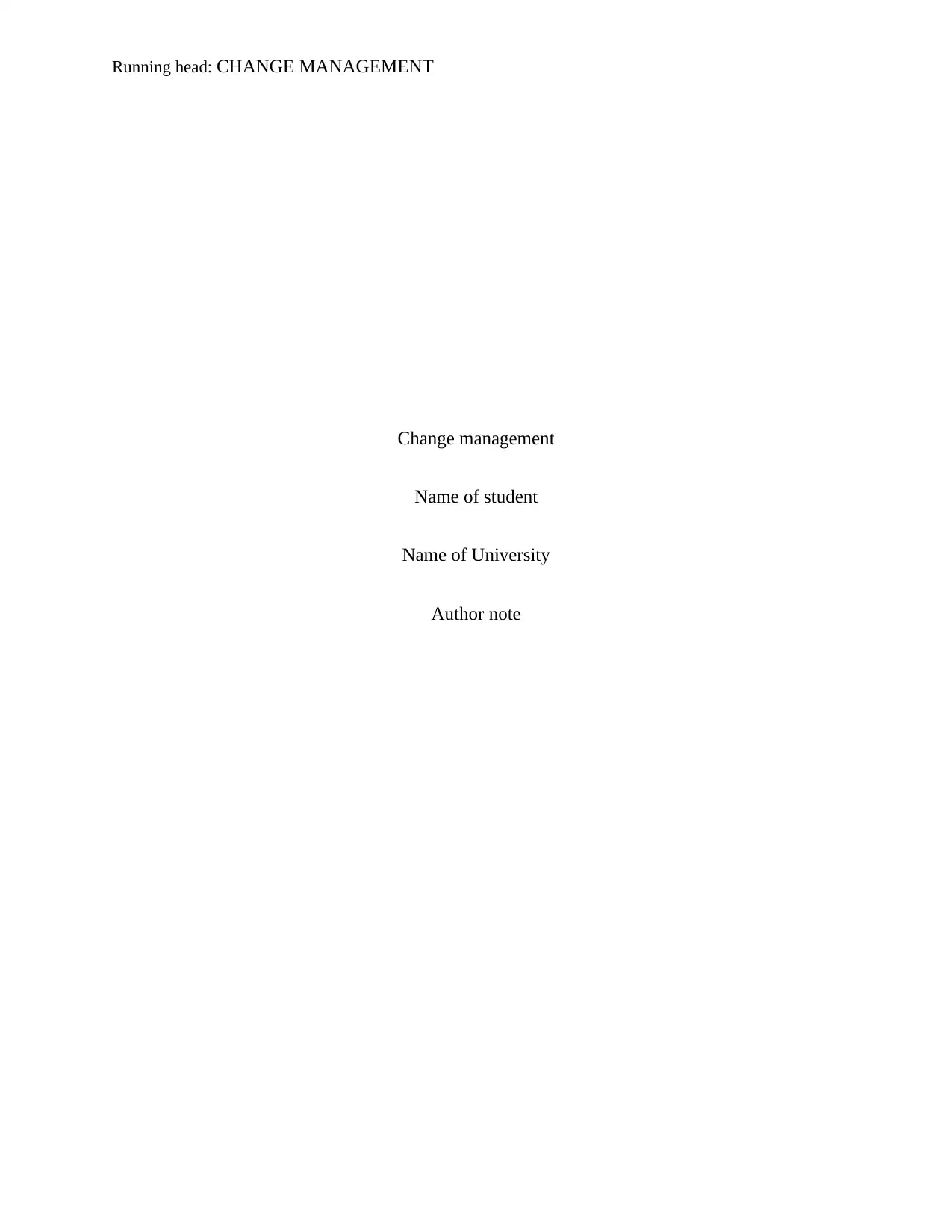
Running head: CHANGE MANAGEMENT
Change management
Name of student
Name of University
Author note
Change management
Name of student
Name of University
Author note
Paraphrase This Document
Need a fresh take? Get an instant paraphrase of this document with our AI Paraphraser
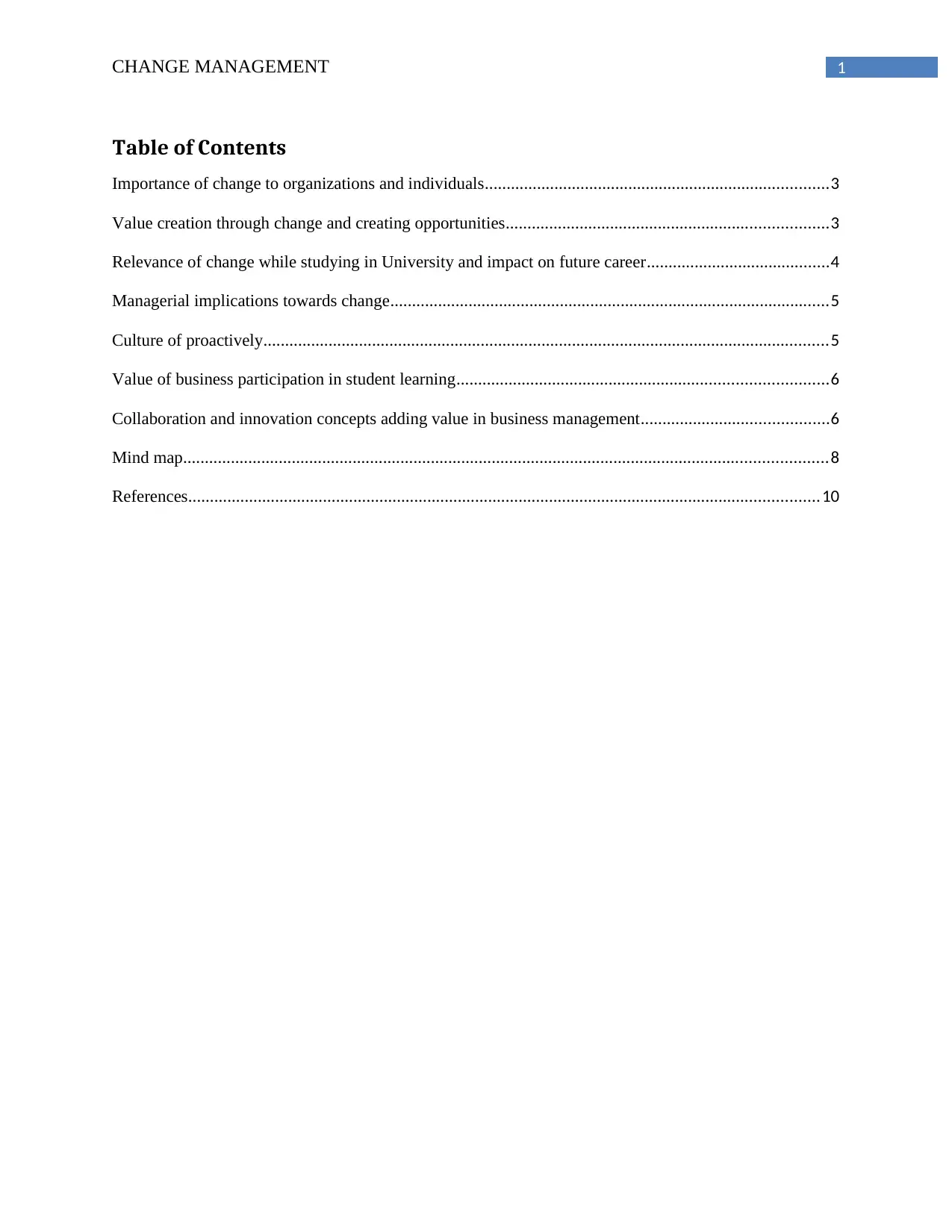
1CHANGE MANAGEMENT
Table of Contents
Importance of change to organizations and individuals...............................................................................3
Value creation through change and creating opportunities..........................................................................3
Relevance of change while studying in University and impact on future career..........................................4
Managerial implications towards change.....................................................................................................5
Culture of proactively..................................................................................................................................5
Value of business participation in student learning.....................................................................................6
Collaboration and innovation concepts adding value in business management...........................................6
Mind map....................................................................................................................................................8
References.................................................................................................................................................10
Table of Contents
Importance of change to organizations and individuals...............................................................................3
Value creation through change and creating opportunities..........................................................................3
Relevance of change while studying in University and impact on future career..........................................4
Managerial implications towards change.....................................................................................................5
Culture of proactively..................................................................................................................................5
Value of business participation in student learning.....................................................................................6
Collaboration and innovation concepts adding value in business management...........................................6
Mind map....................................................................................................................................................8
References.................................................................................................................................................10

2CHANGE MANAGEMENT
Importance of change to organizations and individuals
The human elements of change include the various concepts that were at past and how it
has changed within the organizations. The change management includes managing changes and
development within a business organization and at the same time, enabling controlled
identification and implementation of the changes that are needed to be implemented for
enhancing the organizational efficiency. It can thus be stated as a systematic approach to change
that deals with the transformation of the goals and objectives of the organization along with the
processes and associated technologies. According to Lozano, Ceulemans & Seatter (2015), the
main motive behind change management is to implement the right strategies and bring changes
efficiently, furthermore manage controlled change and create convenience for the people to
allow them adaptable to changes within the organization (Lozano, Ceulemans & Seatter, 2015).
Through changes implemented, the individuals would be able to get into their comfort zones,
furthermore allow for managing relationships and creating transition that was temporary to
transformation, which is ongoing and at present.
Value creation through change and creating opportunities
By enabling changes, not only does the individuals are benefited, but also the
organizations that implement changes to facilitate innovation, collaborative working and creation
of value through increased revenue generation and gaining competitive advantage too. The
organizations have achieved perfection often by bringing changes though adoption of industrial
model of managing work, which has not only reduced the efforts to accomplish a task, but has
also guaranteed the effectiveness and predictability through extraction of values and benefits.
Importance of change to organizations and individuals
The human elements of change include the various concepts that were at past and how it
has changed within the organizations. The change management includes managing changes and
development within a business organization and at the same time, enabling controlled
identification and implementation of the changes that are needed to be implemented for
enhancing the organizational efficiency. It can thus be stated as a systematic approach to change
that deals with the transformation of the goals and objectives of the organization along with the
processes and associated technologies. According to Lozano, Ceulemans & Seatter (2015), the
main motive behind change management is to implement the right strategies and bring changes
efficiently, furthermore manage controlled change and create convenience for the people to
allow them adaptable to changes within the organization (Lozano, Ceulemans & Seatter, 2015).
Through changes implemented, the individuals would be able to get into their comfort zones,
furthermore allow for managing relationships and creating transition that was temporary to
transformation, which is ongoing and at present.
Value creation through change and creating opportunities
By enabling changes, not only does the individuals are benefited, but also the
organizations that implement changes to facilitate innovation, collaborative working and creation
of value through increased revenue generation and gaining competitive advantage too. The
organizations have achieved perfection often by bringing changes though adoption of industrial
model of managing work, which has not only reduced the efforts to accomplish a task, but has
also guaranteed the effectiveness and predictability through extraction of values and benefits.
⊘ This is a preview!⊘
Do you want full access?
Subscribe today to unlock all pages.

Trusted by 1+ million students worldwide
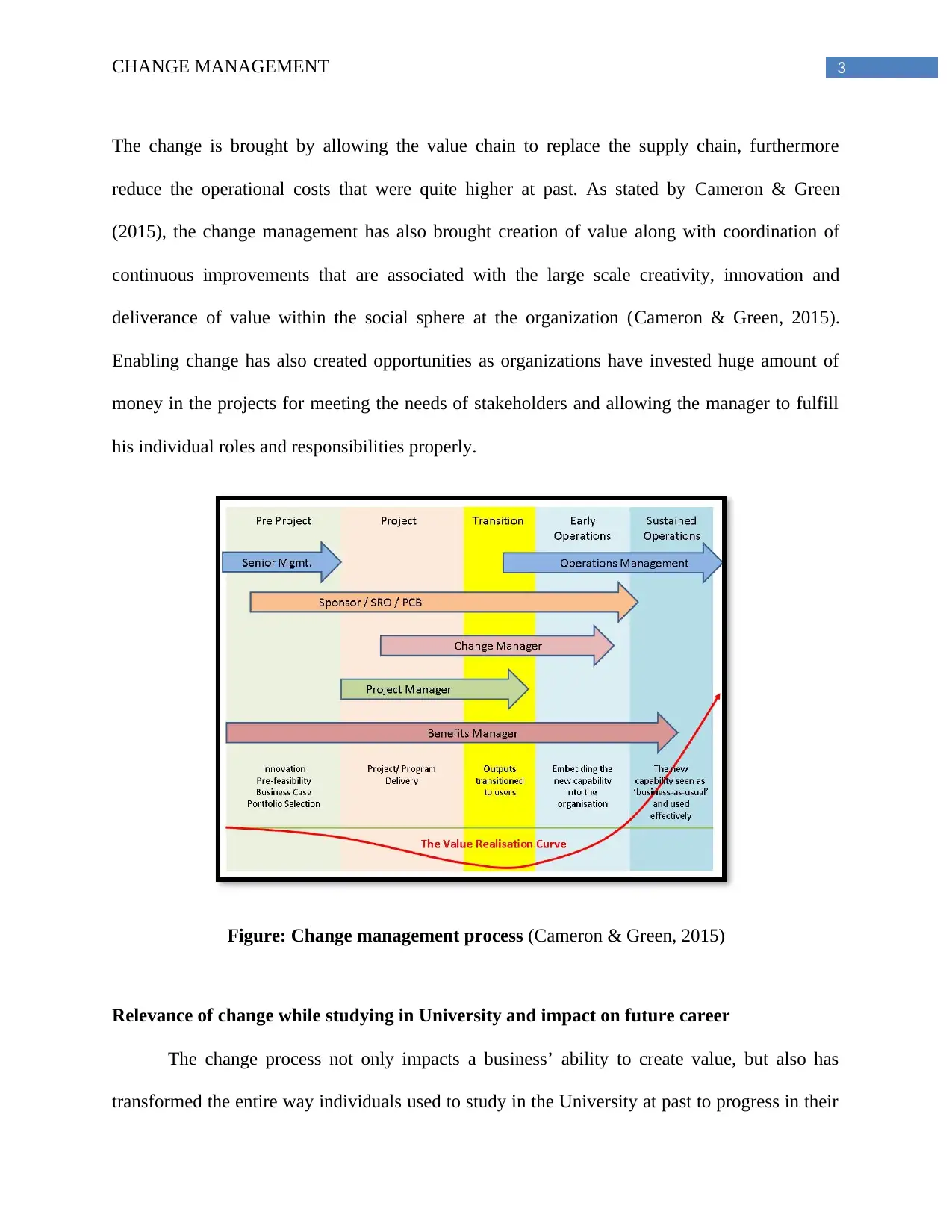
3CHANGE MANAGEMENT
The change is brought by allowing the value chain to replace the supply chain, furthermore
reduce the operational costs that were quite higher at past. As stated by Cameron & Green
(2015), the change management has also brought creation of value along with coordination of
continuous improvements that are associated with the large scale creativity, innovation and
deliverance of value within the social sphere at the organization (Cameron & Green, 2015).
Enabling change has also created opportunities as organizations have invested huge amount of
money in the projects for meeting the needs of stakeholders and allowing the manager to fulfill
his individual roles and responsibilities properly.
Figure: Change management process (Cameron & Green, 2015)
Relevance of change while studying in University and impact on future career
The change process not only impacts a business’ ability to create value, but also has
transformed the entire way individuals used to study in the University at past to progress in their
The change is brought by allowing the value chain to replace the supply chain, furthermore
reduce the operational costs that were quite higher at past. As stated by Cameron & Green
(2015), the change management has also brought creation of value along with coordination of
continuous improvements that are associated with the large scale creativity, innovation and
deliverance of value within the social sphere at the organization (Cameron & Green, 2015).
Enabling change has also created opportunities as organizations have invested huge amount of
money in the projects for meeting the needs of stakeholders and allowing the manager to fulfill
his individual roles and responsibilities properly.
Figure: Change management process (Cameron & Green, 2015)
Relevance of change while studying in University and impact on future career
The change process not only impacts a business’ ability to create value, but also has
transformed the entire way individuals used to study in the University at past to progress in their
Paraphrase This Document
Need a fresh take? Get an instant paraphrase of this document with our AI Paraphraser
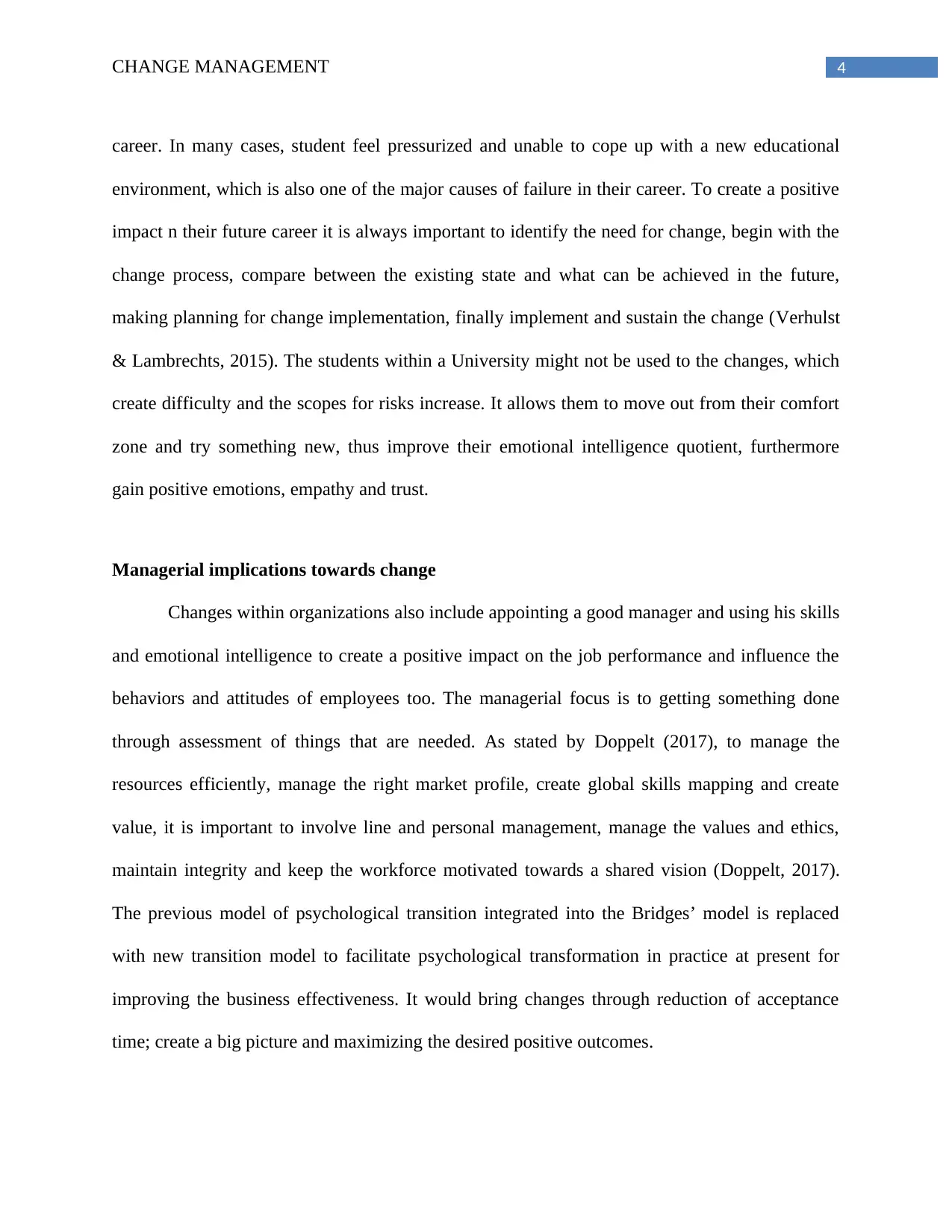
4CHANGE MANAGEMENT
career. In many cases, student feel pressurized and unable to cope up with a new educational
environment, which is also one of the major causes of failure in their career. To create a positive
impact n their future career it is always important to identify the need for change, begin with the
change process, compare between the existing state and what can be achieved in the future,
making planning for change implementation, finally implement and sustain the change (Verhulst
& Lambrechts, 2015). The students within a University might not be used to the changes, which
create difficulty and the scopes for risks increase. It allows them to move out from their comfort
zone and try something new, thus improve their emotional intelligence quotient, furthermore
gain positive emotions, empathy and trust.
Managerial implications towards change
Changes within organizations also include appointing a good manager and using his skills
and emotional intelligence to create a positive impact on the job performance and influence the
behaviors and attitudes of employees too. The managerial focus is to getting something done
through assessment of things that are needed. As stated by Doppelt (2017), to manage the
resources efficiently, manage the right market profile, create global skills mapping and create
value, it is important to involve line and personal management, manage the values and ethics,
maintain integrity and keep the workforce motivated towards a shared vision (Doppelt, 2017).
The previous model of psychological transition integrated into the Bridges’ model is replaced
with new transition model to facilitate psychological transformation in practice at present for
improving the business effectiveness. It would bring changes through reduction of acceptance
time; create a big picture and maximizing the desired positive outcomes.
career. In many cases, student feel pressurized and unable to cope up with a new educational
environment, which is also one of the major causes of failure in their career. To create a positive
impact n their future career it is always important to identify the need for change, begin with the
change process, compare between the existing state and what can be achieved in the future,
making planning for change implementation, finally implement and sustain the change (Verhulst
& Lambrechts, 2015). The students within a University might not be used to the changes, which
create difficulty and the scopes for risks increase. It allows them to move out from their comfort
zone and try something new, thus improve their emotional intelligence quotient, furthermore
gain positive emotions, empathy and trust.
Managerial implications towards change
Changes within organizations also include appointing a good manager and using his skills
and emotional intelligence to create a positive impact on the job performance and influence the
behaviors and attitudes of employees too. The managerial focus is to getting something done
through assessment of things that are needed. As stated by Doppelt (2017), to manage the
resources efficiently, manage the right market profile, create global skills mapping and create
value, it is important to involve line and personal management, manage the values and ethics,
maintain integrity and keep the workforce motivated towards a shared vision (Doppelt, 2017).
The previous model of psychological transition integrated into the Bridges’ model is replaced
with new transition model to facilitate psychological transformation in practice at present for
improving the business effectiveness. It would bring changes through reduction of acceptance
time; create a big picture and maximizing the desired positive outcomes.
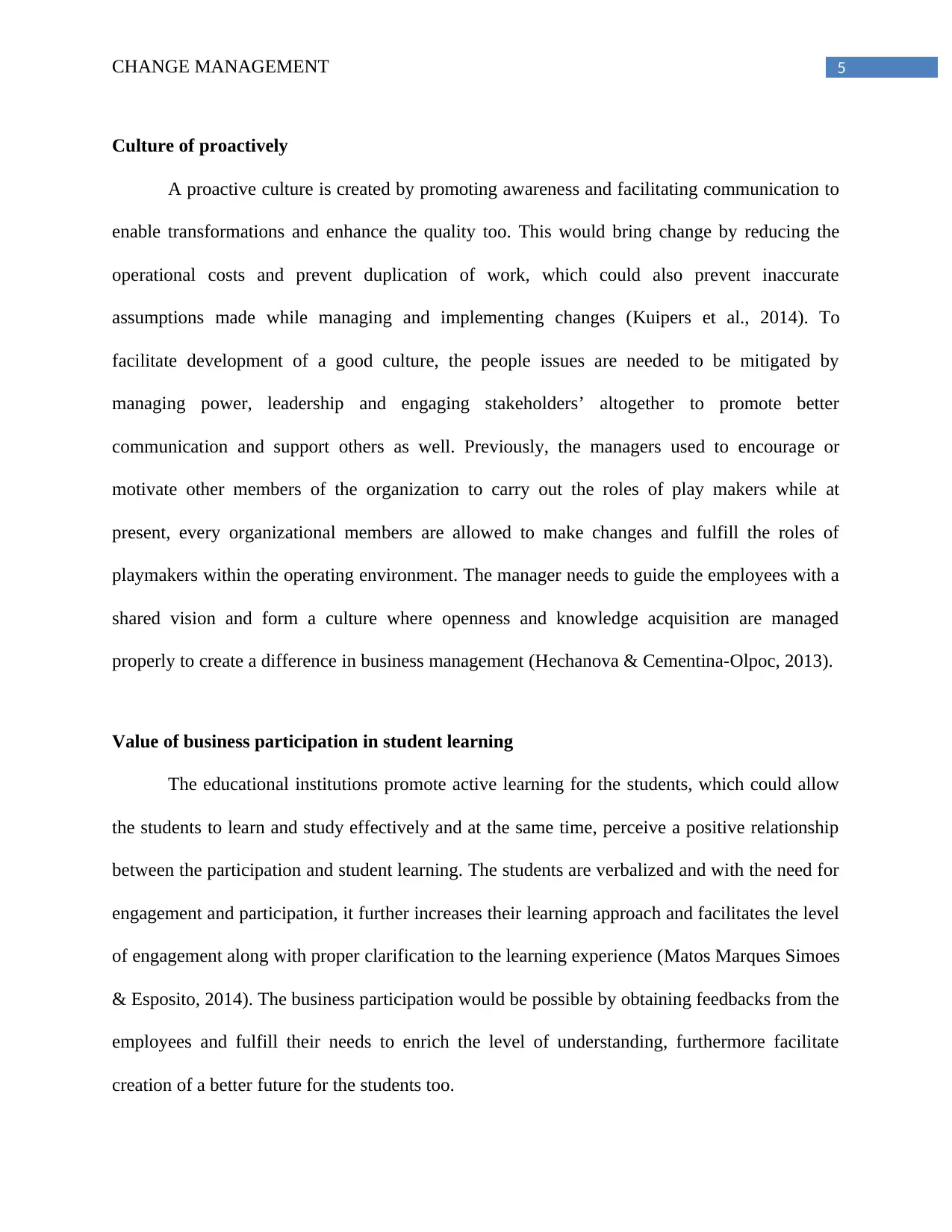
5CHANGE MANAGEMENT
Culture of proactively
A proactive culture is created by promoting awareness and facilitating communication to
enable transformations and enhance the quality too. This would bring change by reducing the
operational costs and prevent duplication of work, which could also prevent inaccurate
assumptions made while managing and implementing changes (Kuipers et al., 2014). To
facilitate development of a good culture, the people issues are needed to be mitigated by
managing power, leadership and engaging stakeholders’ altogether to promote better
communication and support others as well. Previously, the managers used to encourage or
motivate other members of the organization to carry out the roles of play makers while at
present, every organizational members are allowed to make changes and fulfill the roles of
playmakers within the operating environment. The manager needs to guide the employees with a
shared vision and form a culture where openness and knowledge acquisition are managed
properly to create a difference in business management (Hechanova & Cementina-Olpoc, 2013).
Value of business participation in student learning
The educational institutions promote active learning for the students, which could allow
the students to learn and study effectively and at the same time, perceive a positive relationship
between the participation and student learning. The students are verbalized and with the need for
engagement and participation, it further increases their learning approach and facilitates the level
of engagement along with proper clarification to the learning experience (Matos Marques Simoes
& Esposito, 2014). The business participation would be possible by obtaining feedbacks from the
employees and fulfill their needs to enrich the level of understanding, furthermore facilitate
creation of a better future for the students too.
Culture of proactively
A proactive culture is created by promoting awareness and facilitating communication to
enable transformations and enhance the quality too. This would bring change by reducing the
operational costs and prevent duplication of work, which could also prevent inaccurate
assumptions made while managing and implementing changes (Kuipers et al., 2014). To
facilitate development of a good culture, the people issues are needed to be mitigated by
managing power, leadership and engaging stakeholders’ altogether to promote better
communication and support others as well. Previously, the managers used to encourage or
motivate other members of the organization to carry out the roles of play makers while at
present, every organizational members are allowed to make changes and fulfill the roles of
playmakers within the operating environment. The manager needs to guide the employees with a
shared vision and form a culture where openness and knowledge acquisition are managed
properly to create a difference in business management (Hechanova & Cementina-Olpoc, 2013).
Value of business participation in student learning
The educational institutions promote active learning for the students, which could allow
the students to learn and study effectively and at the same time, perceive a positive relationship
between the participation and student learning. The students are verbalized and with the need for
engagement and participation, it further increases their learning approach and facilitates the level
of engagement along with proper clarification to the learning experience (Matos Marques Simoes
& Esposito, 2014). The business participation would be possible by obtaining feedbacks from the
employees and fulfill their needs to enrich the level of understanding, furthermore facilitate
creation of a better future for the students too.
⊘ This is a preview!⊘
Do you want full access?
Subscribe today to unlock all pages.

Trusted by 1+ million students worldwide
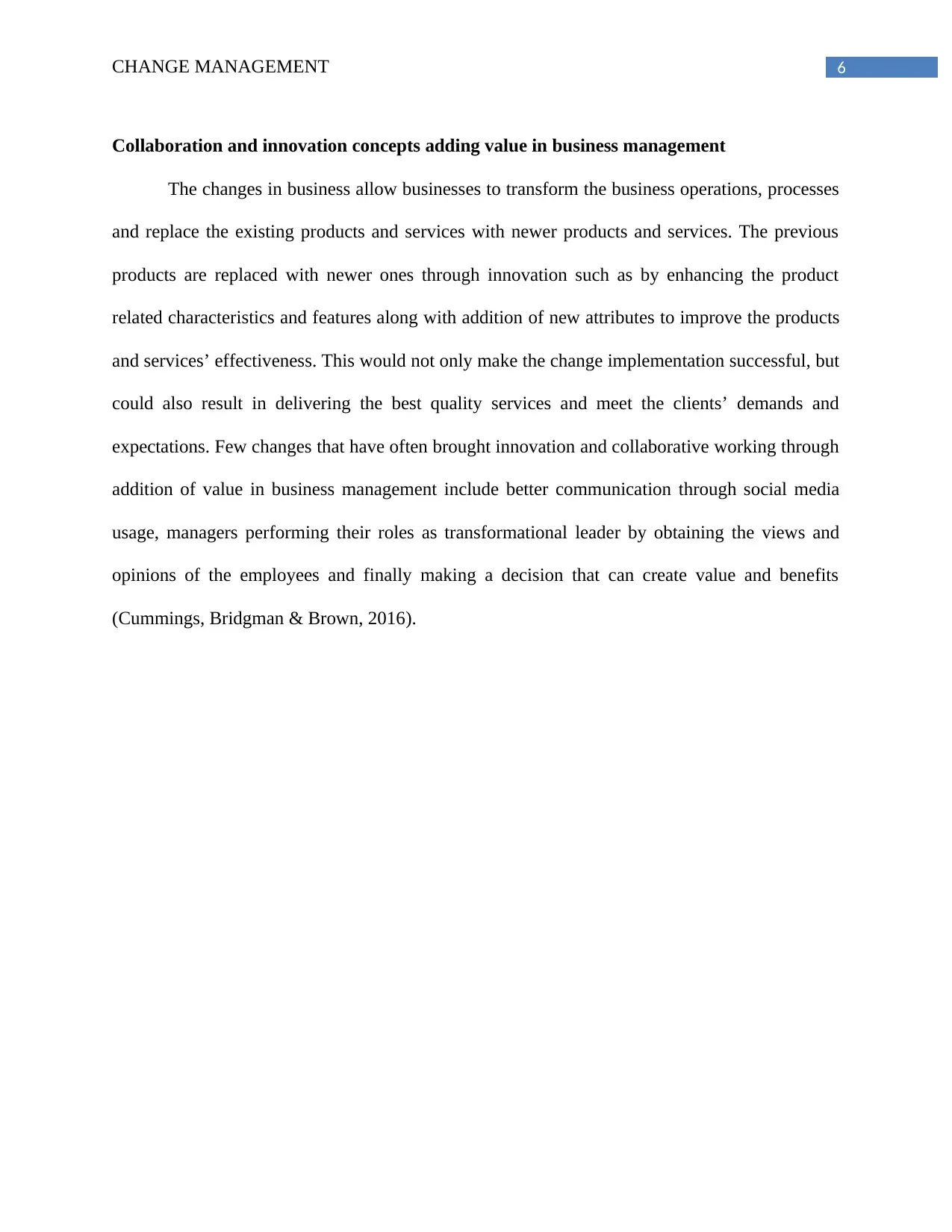
6CHANGE MANAGEMENT
Collaboration and innovation concepts adding value in business management
The changes in business allow businesses to transform the business operations, processes
and replace the existing products and services with newer products and services. The previous
products are replaced with newer ones through innovation such as by enhancing the product
related characteristics and features along with addition of new attributes to improve the products
and services’ effectiveness. This would not only make the change implementation successful, but
could also result in delivering the best quality services and meet the clients’ demands and
expectations. Few changes that have often brought innovation and collaborative working through
addition of value in business management include better communication through social media
usage, managers performing their roles as transformational leader by obtaining the views and
opinions of the employees and finally making a decision that can create value and benefits
(Cummings, Bridgman & Brown, 2016).
Collaboration and innovation concepts adding value in business management
The changes in business allow businesses to transform the business operations, processes
and replace the existing products and services with newer products and services. The previous
products are replaced with newer ones through innovation such as by enhancing the product
related characteristics and features along with addition of new attributes to improve the products
and services’ effectiveness. This would not only make the change implementation successful, but
could also result in delivering the best quality services and meet the clients’ demands and
expectations. Few changes that have often brought innovation and collaborative working through
addition of value in business management include better communication through social media
usage, managers performing their roles as transformational leader by obtaining the views and
opinions of the employees and finally making a decision that can create value and benefits
(Cummings, Bridgman & Brown, 2016).
Paraphrase This Document
Need a fresh take? Get an instant paraphrase of this document with our AI Paraphraser

7CHANGE MANAGEMENT
Mind map
Mind map
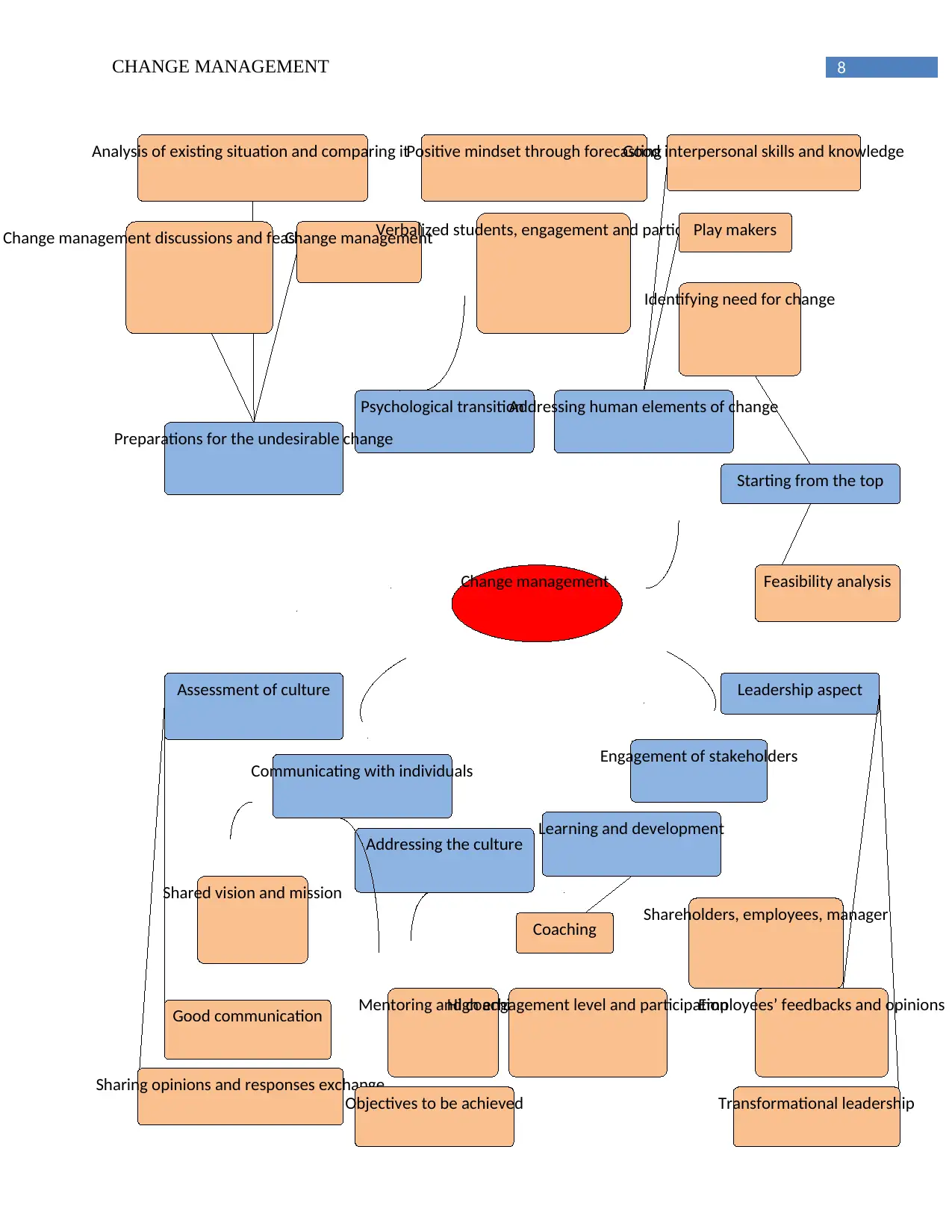
8
Change management
Psychological transition
Preparations for the undesirable change
Assessment of culture
Communicating with individuals
Addressing the culture Learning and development
Addressing human elements of change
Starting from the top
Leadership aspect
Engagement of stakeholders
Change management discussions and feasibility analysis
Analysis of existing situation and comparing it
Change management
Verbalized students, engagement and participation
Positive mindset through forecastingGood interpersonal skills and knowledge
Play makers
Sharing opinions and responses exchange
Good communication
Shared vision and mission
Objectives to be achieved
Mentoring and coachingHigh engagement level and participation
Transformational leadership
Employees’ feedbacks and opinions
Shareholders, employees, manager
Coaching
Identifying need for change
Feasibility analysis
CHANGE MANAGEMENT
Change management
Psychological transition
Preparations for the undesirable change
Assessment of culture
Communicating with individuals
Addressing the culture Learning and development
Addressing human elements of change
Starting from the top
Leadership aspect
Engagement of stakeholders
Change management discussions and feasibility analysis
Analysis of existing situation and comparing it
Change management
Verbalized students, engagement and participation
Positive mindset through forecastingGood interpersonal skills and knowledge
Play makers
Sharing opinions and responses exchange
Good communication
Shared vision and mission
Objectives to be achieved
Mentoring and coachingHigh engagement level and participation
Transformational leadership
Employees’ feedbacks and opinions
Shareholders, employees, manager
Coaching
Identifying need for change
Feasibility analysis
CHANGE MANAGEMENT
⊘ This is a preview!⊘
Do you want full access?
Subscribe today to unlock all pages.

Trusted by 1+ million students worldwide
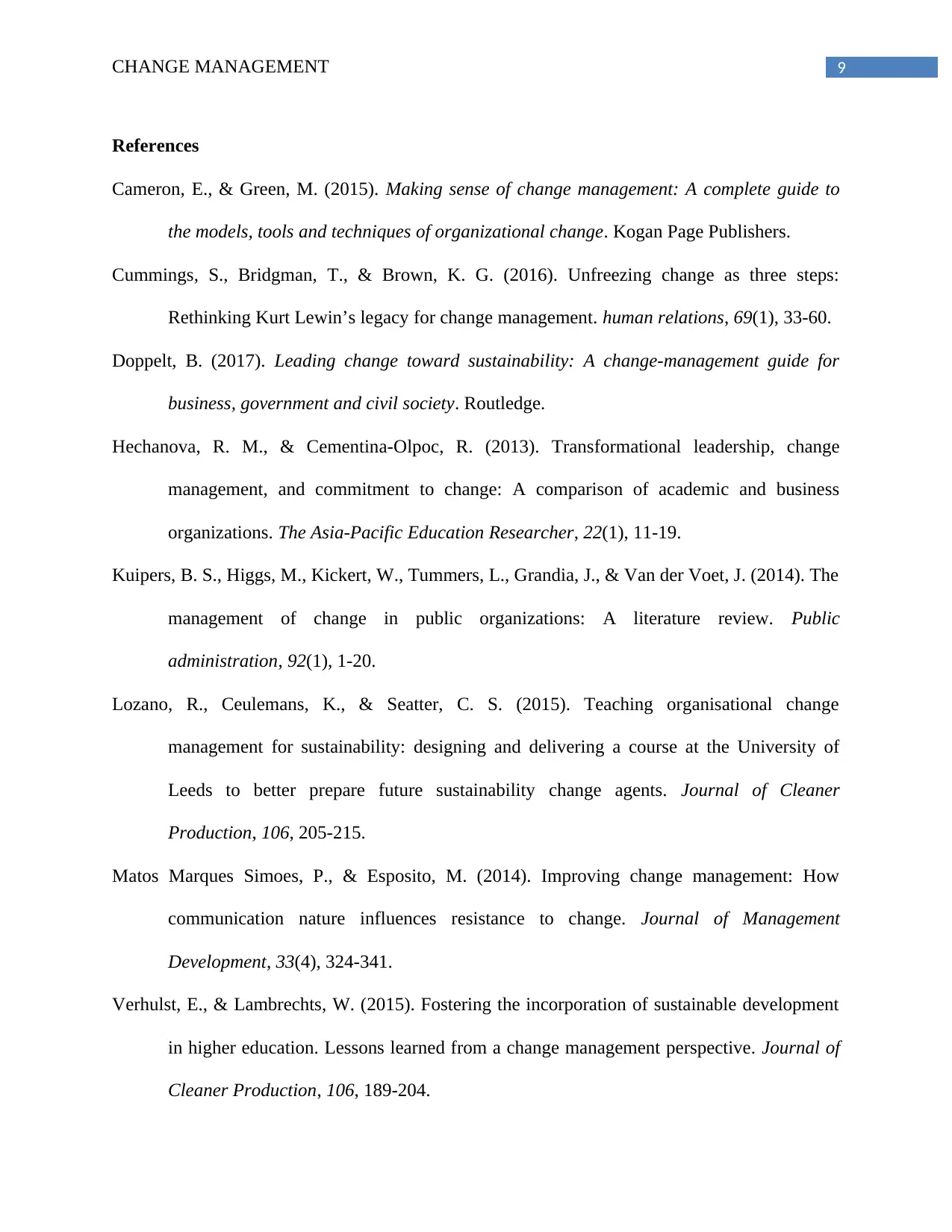
9CHANGE MANAGEMENT
References
Cameron, E., & Green, M. (2015). Making sense of change management: A complete guide to
the models, tools and techniques of organizational change. Kogan Page Publishers.
Cummings, S., Bridgman, T., & Brown, K. G. (2016). Unfreezing change as three steps:
Rethinking Kurt Lewin’s legacy for change management. human relations, 69(1), 33-60.
Doppelt, B. (2017). Leading change toward sustainability: A change-management guide for
business, government and civil society. Routledge.
Hechanova, R. M., & Cementina-Olpoc, R. (2013). Transformational leadership, change
management, and commitment to change: A comparison of academic and business
organizations. The Asia-Pacific Education Researcher, 22(1), 11-19.
Kuipers, B. S., Higgs, M., Kickert, W., Tummers, L., Grandia, J., & Van der Voet, J. (2014). The
management of change in public organizations: A literature review. Public
administration, 92(1), 1-20.
Lozano, R., Ceulemans, K., & Seatter, C. S. (2015). Teaching organisational change
management for sustainability: designing and delivering a course at the University of
Leeds to better prepare future sustainability change agents. Journal of Cleaner
Production, 106, 205-215.
Matos Marques Simoes, P., & Esposito, M. (2014). Improving change management: How
communication nature influences resistance to change. Journal of Management
Development, 33(4), 324-341.
Verhulst, E., & Lambrechts, W. (2015). Fostering the incorporation of sustainable development
in higher education. Lessons learned from a change management perspective. Journal of
Cleaner Production, 106, 189-204.
References
Cameron, E., & Green, M. (2015). Making sense of change management: A complete guide to
the models, tools and techniques of organizational change. Kogan Page Publishers.
Cummings, S., Bridgman, T., & Brown, K. G. (2016). Unfreezing change as three steps:
Rethinking Kurt Lewin’s legacy for change management. human relations, 69(1), 33-60.
Doppelt, B. (2017). Leading change toward sustainability: A change-management guide for
business, government and civil society. Routledge.
Hechanova, R. M., & Cementina-Olpoc, R. (2013). Transformational leadership, change
management, and commitment to change: A comparison of academic and business
organizations. The Asia-Pacific Education Researcher, 22(1), 11-19.
Kuipers, B. S., Higgs, M., Kickert, W., Tummers, L., Grandia, J., & Van der Voet, J. (2014). The
management of change in public organizations: A literature review. Public
administration, 92(1), 1-20.
Lozano, R., Ceulemans, K., & Seatter, C. S. (2015). Teaching organisational change
management for sustainability: designing and delivering a course at the University of
Leeds to better prepare future sustainability change agents. Journal of Cleaner
Production, 106, 205-215.
Matos Marques Simoes, P., & Esposito, M. (2014). Improving change management: How
communication nature influences resistance to change. Journal of Management
Development, 33(4), 324-341.
Verhulst, E., & Lambrechts, W. (2015). Fostering the incorporation of sustainable development
in higher education. Lessons learned from a change management perspective. Journal of
Cleaner Production, 106, 189-204.
Paraphrase This Document
Need a fresh take? Get an instant paraphrase of this document with our AI Paraphraser

10CHANGE MANAGEMENT
1 out of 11
Related Documents
Your All-in-One AI-Powered Toolkit for Academic Success.
+13062052269
info@desklib.com
Available 24*7 on WhatsApp / Email
![[object Object]](/_next/static/media/star-bottom.7253800d.svg)
Unlock your academic potential
Copyright © 2020–2025 A2Z Services. All Rights Reserved. Developed and managed by ZUCOL.





